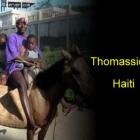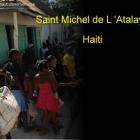ADVERTISEMENT
Haiti
Christianity and Voodoo Co-Habitate in Anse-a-Foleur
In the Nord Ouest Department located within Saint-Louis-du-Nord Arrondissement sits Anse-à-Foleur. Lying just above sea level, it is home to a population of 18,100 inhabitants.
Locals in Anse-à-Foleur follow the officially recognized creed, Christianity. But as is common in other Haitian communities, Voodoo also exists. The village is home to a Voodoo church that contains many maze-like corridors, and the fenced-in area outside contains a pond, filled with dirty water at mid-calf level. The purpose of the pond is to purify sins, a Christian concept.
To give some background on how the practice of Voodoo and Christian concept of sin came to be associated, it begins with the immigration of Congolese slaves to Hispaniola. The slaves brought with them their belief in the Loa, a supreme deity who possesses the bodies of chosen aspirants. To be possessed by the Loa is an honor, and ritual dances with chickens and Voodoo drums entice the Loa to appear. When European settlers seized control of Hispaniola, they forbade the pagan practice of Voodoo. But Voodoo shamans found aspects of Christianity appealing, and began incorporating them into their ceremonies. Today Christian and Voodoo believers live in harmony.
Government of Haiti's Favorite Child, Bas-Peu-de-Chose
Bas-Peu-de-Chose is a community for rich Haitians. A quiet neighborhood, each block contains only a handful of properties, with fenced-in yards, land-scaped lawns, and fruit trees. Inhabitants are government ministers, doctors, clergy, military, and relatives of highly-placed government officials.
Some of the homes are modest, others palatial, survivors of the colonial period. But all contain one, or several varieties of trees, among them cherry, breadfruit, grape, orange, and coconut. Birds abound, pecking at the dew-moistened grass in the early mornings.
Besides the verdant environment, one other element sets the neighborhood apart from many communities in Haiti, the paved roads. Why this particular anomaly in Bas-Peu-de-Chose? Haiti is a country so poor it occupies a permanent spot on the failed states index. One does not need to look far for the answer. Bas-Peu-de-Chose is the government of Haiti's (GOH) extended family of retired government ministers, military officers, and mothers of ex-presidents.
Bassins Bleu Haiti's Pride and Joy
Bassins Bleu's waterfalls are secreted high in the hills above the jewel of Jacmel Bay. The terrain surrounding the falls is rugged with tors and deep gorges, lush vegetation, and vibrant-hued tropical birds, perching in trees. Abundant forest-cover suffuses the hills and valleys. The Haiti tourist bureau, recognizing the waterfalls as a drawing card, has promoted it as the can't-miss spot to visit.
To access Bassins Bleu, you must travel either by horse or recreational vehicle. Once there, you can explore the falls by high-diving off an outcropping into the basins, frolic underneath the falls, or discover one of many caves made private by tall-standing forest vegetation. Several waterfalls make up Bassins Bleu, but three stand out as exquisite: Bassin Palmiste, Bassin Yes, and Bassin Clair.
Haiti First-Time Host for Diplomatic Summit
Haiti has been putting plans in place to ensure their hosting of the Fifth Summit of the Organization of Caribbean States goes smoothly. Twenty-five participant nations, who will send approximately 300 representatives from the top tiers of their governments, will unite to support this year's topic of discussion: "Revitalizing the Vision of the Association of Caribbean States for a Stronger and More United Greater Caribbean".
In anticipation of the event, a pre-planning session was scheduled at the Karibe Convention Center in early April. A group of 50 international representatives met to assess what tasks remained to complete preparations. They reviewed areas of official procedure, timed press releases, media consultants, and security measures to ensure a well-run operation.
Huge Development and Tourism Plans for Ile a Vache, Haiti
Most of the recent developmental agendas relating to Haiti pointed out to one common aspect - tourism. Haiti is blessed with Ile a Vache island located off Les Cayes' southeast coat. Spanning over an area of 52 sq. km. this island, as mentioned by Tourism Ministry, is the final frontier of true Caribbean treasure. The Ministry of Tourism is aiming towards developing a sustainable tourism industry in Ile a Vache that will help to improve the standard of living for the locals and at the same time, open doors for cross-border tourism.
The aim of the Ministry of Tourism is to create a low-density development focusing on eco-tourism while highlighting areas like history, agro-tourism and cultural heritage that will cover 20 beaches that are mostly deserted. The plan also includes solar-powered electricity-run vehicles instead of regular cars. The Ministry plans on attracting investors from countries like wider Caribbean, China, Qatar and Dominican Republic.
Tension in the border Anse-a-Pitres and Pedernales
In the wake of the Dominican Republic's new 2,500 peso tax on the issuing of passports, an ongoing protest has been staged at the border of Anse-a-Pitres and Pedernales. Dozens of people, including taxi drivers, merchants and changers, took to the border and set up a barricade of large, heavy stones and tires etc. that they set ablaze and constantly reinforce to maintain the fortitude of the roadblock.
The protest action began on Thursday, at the border's south-east entrance, and has been carried on into market day, Friday, successfully shutting down business and commercial activities in the area. Demonstrators are very vocal about their condemnation of this new tax. A representative of the traders association claimed the protest would continue through to the end of the week, citing that a 2,500 peso tax on passports was 'completely irregular'. Similar tales of dissension have been told by members of the GARR (Group for Repatriates and Refugees), making the public very aware of their intolerance of this new tax.
Government of Haiti Keeps Country from Moving Ahead
Statistics about Haiti were last available in 2000, when Jean-Bertrand Aristide began his second-term presidency. And things have not changed much. Still considered the poorest nation in the Western Hemisphere, it has remained on the index of failed states.
It experiences a tropical, and in some places, semi-arid climate. Agriculture, the most vital indicator of the economy, accounts for 32% domestic output, with a 70% poverty rate reliant on it. Natural disasters assault Haiti with regularity. In 2012, two hurricanes ravaged the island within months of each other. And deforestation has left only 4% of arable land for agriculture production.
Kita Nago Haiti's National Pride
Kita Nago is a cedarwood stanchion, lifted onto the shoulders of participants, and carried on a 700-kilometer journey from the southwest to the northeast corner of Haiti. Harry Nicolas first thought of a procession that would travel through 45 cities and 7 departments, wending from Les Irois in the south to Ouanaminthe in the north, more than 3 decades ago. He wanted to create an event that would unite Haitians across all cultural and class divides. He had envisioned the project when barely out of his teens, but postponed it after being counseled he lacked sufficient maturity to undertake it. He agreed to wait.
Kita Nago, from Les Irois to Ouanaminthe, a symbol of Haitian Unity
Who would have thought that Haitians could decide to start a pilgrimage or parade by taking a piece of wood from one end of Haiti to the other end, on food and no compensation?
Harry Nicolas, nicknamed Mèt Fèy Vèt did. Harry Nicholas the person who came up with the idea of Kita Nago is a true Haitian believer. He is the one who came up with the idea of organizing a movement were Haitians would carry for not less than 700 kilometers from Les Irois to Ouanaminthe. They will be walking across Haiti, from the western tip southern peninsula, all the way to the northeast corner of Haiti.
Haiti Included In The List Of World's Worst Places To Live
A series of calamities that struck Haiti in the past years has taken a toll on the country's image. Haiti was included in a list of the world's worst places to live in made by consulting firm Mercer. According to the list, Haiti ranked third among the countries with the worst quality of living, just two places behind Iraq. Port-au-Prince was particularly mentioned as a city that does not offer a great quality of life to residents.
When it comes to infrastructure, the capital of Port-au-Prince was number one in the list of countries with worst infrastructure. Mercer cited various contributing factors such as availability and supply of electricity, fresh water and public transportation as the reasons why the country was ranked that way.
Our objective is to share with you news and information about Haiti and the people of Haiti. Traditions, habits and the way we were or grew are alive in this site. We highly recommend that you Subscribe to our Newsletter and also share with us some of the things that are memorable and made us unique people.

 Informative Marketing and Advertising in the Haitian Community
Informative Marketing and Advertising in the Haitian Community  Haitian Creole Translation
Haitian Creole Translation  Thomassique, Haiti
Thomassique, Haiti  Saint Michel de L 'Atalaye
Saint Michel de L 'Atalaye  Haitians are a Proud People
Haitians are a Proud People